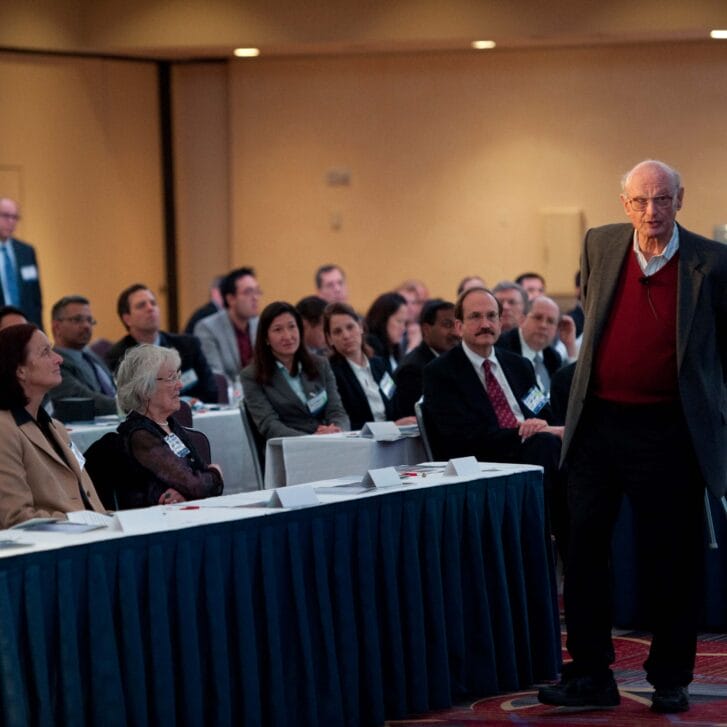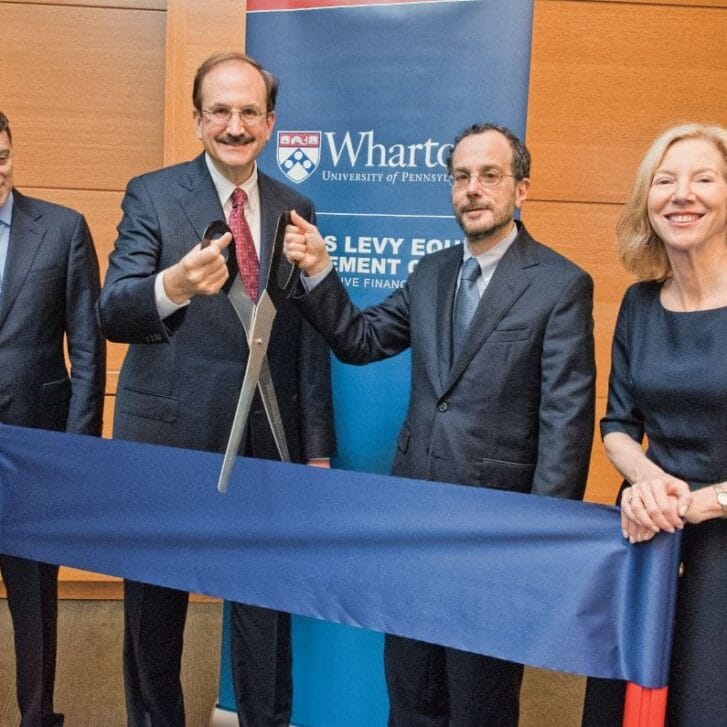Naturally, the authors of a book on visual marketing would pay close attention to its cover. Before marketing professor Barbara Kahn arrived for our interview in the Wharton Neuroscience Initiative offices, WiN executive director Elizabeth “Zab” Johnson offered a sneak peek at the new book she co-wrote with Kahn, Visual Marketing. She displayed its geometric eyeball design before flipping it over to reveal a descriptive blurb on the back that had gone through several iterations. Johnson’s attention to detail is one trait Kahn credits for the success of the course the two teach together. The professors sat down to discuss the concepts that inspired the book and the foundation for their cross-discipline partnership.
Wharton Magazine: You’ve been teaching Visual Marketing together for six years. What inspired the course?
Elizabeth “Zab” Johnson: I was pretty new to Wharton and new to a business school. Barbara and I were sitting next to each other in a faculty lunch, and she asked me a pretty benign question: “What are you working on?” I said, “I’m thinking about developing a course on visual marketing,” to which she responded, “That’s what I do!” [Both laugh]
Barbara Kahn: For 25 years, I’ve collaborated on courses. There’s work in collaborating. You don’t save time, but it’s worth it, because the courses are richer.
WM: Why did you decide to write Visual Marketing?
Johnson: We’re trying to encourage people to think through this lens about the ways that you can frame the future and the “now” of marketing. There’s a really rich consumer-behavior world out there, but there’s nobody thinking very comprehensively around the importance of visual information and how complex it can be and trying to strip that down into its component parts. We would see it as a win if other business schools around the world start to think about this as a class, because that’s what’s going to move the dial.
WM: Visual Marketing describes a “post-pandemic digital transformation” in marketing. How has the role of the brick-and-mortar store changed post-pandemic?
Kahn: When I wrote The Shopping Revolution [in 2018], people were announcing “the retail apocalypse,” because 7,800 stores closed. And then COVID happened, and another 12,000 stores closed. In 2024, another 7,000 stores closed. So traditional physical retail keeps evolving. Just being a mini-distribution center for people to come in and pick up the product — that’s not how people think about retail anymore. You’ve got to think about it more experientially: Why are they coming into the store? A lot of people are throwing spaghetti at the wall to see what sticks.
WM: What surprised you most in your research for the book?
Johnson: From the marketing perspective, so much has changed, and yet the approaches are still what they were so many years ago. Some people think that attention spans have shortened, and I try to convince them that’s actually not the case. It’s just that the information landscape is richer, so people are foraging for information more rapidly. That’s just an evolution of what technology allows us to find and how easy it is to give up. We know one thing and move on to the next thing. That’s fundamentally biological. The consumer, if they’re engaged with your content, will stick with it. But you have to think about what you’re presenting to them and the context in which you’re doing that. And [think about] the expectations of what a consumer will see, take in, understand, and respond to in an information-rich environment.
WM: You introduce a concept called “the treasure hunt” to describe shopping. How does this play into our psychology as consumers?
Kahn: Someone who’s doing a great job of that is Sephora. They kind of invented a new notion of the customer experience. One of the things that Sephora did to drive people out of the department stores was to put everything out on the counter so you could play with it. Typically, cosmetics were sold behind the counter, and you had to go through an aggressive salesperson to get that stuff.
Another treasure hunt is what Costco does. You never know where anything is. It’s a huge warehouse. It’s very much touch-and-go whether you’re going to get whatever you want. It’s crazy like a fox, because they managed to make it into a very fun thing. But it’s not the same kind of impulse-buy discovery that you might imagine in a store like Sephora or Target. And then the third treasure hunt is what T.J. Maxx does, where it’s “Shove everything together and then make people sift through it.”
So there are very strong business reasons for each. But from a visual marketing point of view, they’re playing around with the visual principles in really different ways.
WM: You describe a study that used rapid serial visual presentation, where six pictures were displayed at extremely high speeds. Can you tell us more about this experiment?
Johnson: That’s a method that’s used a lot in my field. A lot of what we talk about in the course and in the book is about “fluency” — something that is easy to process, which means that you understand it without having to apply a lot of cognitive power to suss it out. There are certainly situations where you don’t want it to be fluent for a strategy reason.
Kahn: Let’s say Costco.
Johnson: Yes, exactly. Or a puzzle where you want people to stick with your content because there’s going to be a revealing moment for them. But in the idea of fluency, one of the experimental ways to probe that is to understand: Can people remember the thing that you showed them very quickly and in a rapid series? In that particular case in the book’s memorability chapter, it was a methodology to check whether images that were more likely to be remembered were easier to process.
It turns out that you don’t just have to make things up. You can actually use guiding foundational principles to design a more effective logo or advertisement or shelving display or retail experience. That’s what we try to convince our students of, too: You don’t necessarily have to run experiments. I could tell you that if you put blue at the bottom of your logo, people will perceive it as being heavier. There are rules.
WM: Interesting. How are you so sure those rules never shift?
Johnson: There are these cognitive laws. Part of that is innate and hardwired, and some of that is learned through our experiences.
Kahn: She typically talks more about the hard-wired things, and I talk more about learned associations. We know if you walk down the soup aisle, for example, and you see red, that’s going to be Campbell’s, and you’re going to process that as Campbell’s. There are some things that are hard-wired, like some colors create more arousal.
WM: What does the future of visual marketing look like?
Kahn: I think what we’re trying to show is, the basic principles are going to be the same: Give your customers something they want that’s better than the competition. But what does that mean in the gaming world? In the AI world? We need to update our examples, and we need to make sure we bring our students along with us. But our basic principles that we’re teaching are pretty fundamental.
From the day we met, we’ve always had this idea. What’s changed over time was learning each other’s style and integrating and seeing the parallels. That’s why we didn’t write the book until just recently — because we were waiting for it all to kind of settle out. We really invented this course. Not that we invented visual marketing, but in terms of teaching it in a structured way, I don’t believe anybody’s ever done it.
Published as “Think! See! Buy!” in the Spring/Summer 2025 issue of Wharton Magazine.

























